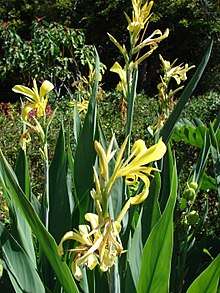Canna glauca
Canna glauca is a species of the Canna genus, a member of the family Cannaceae. It is native to the wetlands of tropical America and was introduced to England in 1730. It is also reportedly naturalized in Sri Lanka, Thailand, Vietnam, Java and the Philippines.[2]
| Canna glauca | |
|---|---|
 | |
| Scientific classification | |
| Kingdom: | Plantae |
| Clade: | Tracheophytes |
| Clade: | Angiosperms |
| Clade: | Monocots |
| Clade: | Commelinids |
| Order: | Zingiberales |
| Family: | Cannaceae |
| Genus: | Canna |
| Species: | C. glauca |
| Binomial name | |
| Canna glauca | |
| Synonyms | |
| |
Description
Herb up to 1.5 tall, with narrow, blue-green (glaucous) leaves, atop of which sit its large, delicate, pale yellow flowers.
Distribution and habitat
C. glauca is native to the southeastern and south-central United States (Texas, Florida, Louisiana and South Carolina) as well as Mexico, Central America, South America and the West Indies. It is an aquatic species, growing as a marginal plant in up to about 15 cm of still or slow-moving water.
Taxonomy
Nobuyuki Tanaka, one of the leading researchers on genus Canna, recognises two varieties of Canna glauca:[3] Canna glauca var. glauca and Canna glauca var. siamensis (Kraenzl) N.Tanaka. The latter variety widespread in South and Southeast Asia, where it is supposed to have differentiated within the past few centuries.
Cultivation
The species prefers light (sandy), medium (loamy) and heavy (clay) soils and requires well-drained soil. The preferred soil is acid, neutral and basic (alkaline). It cannot grow in the shade and requires moist soil.[4] It is hardy to zone 10 and is frost tender. In the north latitudes it is in flower from August to October, and the seeds ripen in October.[5]
Gallery
Notes
- Raf. Fl. Ludov. 143 1817
- Kew World Checklist of Selected Plant Families, Canna glauca
- Tanaka, N. 2001. Taxonomic revision of the family Cannaceae in the New World and Asia. Makinoa ser. 2, 1:34–43.
- Cooke, Ian, 2001. The Gardener's Guide to Growing cannas, Timber Press. ISBN 0-88192-513-6
- Johnson's Gardner's Dictionary (1856)


